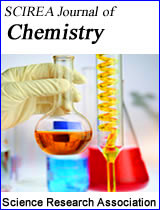Topological approach to atomic charges, electric moments, axial vectors, spontaneous polarization and optical rotation in α-LiIO3 at 296 K.
DOI: 10.54647/chemistry15232 80 Downloads 164848 Views
Author(s)
Abstract
Optical rotation and spontaneous polarization are determined from the point charge model in four structure descriptions of a chiral ionic solid α-LiIO3 crystal. Net atomic charges of I and O atoms are iterated under ionic constraints. The inverted ratio of the second electric moments, derived from the polar vectors of second rank in the semi-axis directions of the quadric around the iodate ion, is fitted equal to the ratio of the optical refractive indices in the semi-axis directions of the indicatrix. The principal refractive indices contain information about the axial vectors of second rank, which are formed through vector cross products between a wave vector in the propagation direction of light and the second electric moments acting in the two other semi-axis directions of the quadric. The calculated axial vectors reveal the magnitude of rotation and the handedness of the dominant vector of them gives the sense of optical rotation character of the crystal. They are converted to the principal gyration tensor components and the sense and magnitude of optical rotation is determined in the direction of the optic axis. The sense and magnitude of the spontaneous polarization vectors are computed in the four structure alternatives. The enantiomorphic pairs are identified amongst the four structure descriptions and the absolute crystal structure of α-LiIO3 is discussed.
Keywords
LiIO3, atomic charges, electric moments, polar and axial vectors spontaneous polarization,optical rotation
Cite this paper
M. Karppinen,
Topological approach to atomic charges, electric moments, axial vectors, spontaneous polarization and optical rotation in α-LiIO3 at 296 K.
, SCIREA Journal of Chemistry.
Volume 7, Issue 1, February 2022 | PP. 1-18.
10.54647/chemistry15232
References
| [ 1 ] | Flack, H. D. (2003). Helvetica Chimica Acta, Vol. 86, 905-920. |
| [ 2 ] | Rosenzweig, A. & Morosin, B. (1966). Acta Crystallogr. 20, 758-761. |
| [ 3 ] | Morosin, B., (1972). Private Communication, quoted as Ref.25 of Bergman, J.G. & Crane, G. R. (1974) J. Chem. Phys. 60, 2470-2474. |
| [ 4 ] | Li Yin-Yuan, Fan Hai-fu & Chia-Shou-chuan. (1973). Sci. Sin. (Engl. Ed.) 16, 130 - 135. |
| [ 5 ] | Svensson, C., Albertsson J., Liminga, R., Kvick, Å.& Abrahams, S.C. (1983). J. Chem. Phys. 78, 7343-7352. |
| [ 6 ] | Stadnicka, K., Glazer, A. M., & Moxon, J. R. L. (1985) J. Appl. Crystallogr. 18, 237-240. |
| [ 7 ] | Abrahams, S. C. (1994). Acta Crystallogr. Sect. A 50, 658-685. |
| [ 8 ] | Turner, E. H. (1976). J. Appl. Crystallogr. 9,52. |
| [ 9 ] | Liminga R. & Abrahams, S. C. (1976). J. Appl. Crystallogr. 9, 42-47. |
| [ 10 ] | IEEE Standard 176, (1949). Proc. IRE. 37, 1378-1395. |
| [ 11 ] | Yang Hua-guang, Zhang Dao-fan, Chen Wan-chun & Li Yin-Yuan (1989). J. Appl. Crystallogr. 22, 144-149. |
| [ 12 ] | Oseen, C. W. (1915). Ann. Phys. (Leipzig), 48, 1-56. |
| [ 13 ] | Born, M. (1922). Z. Phys. 8, 390-417. |
| [ 14 ] | Ramachandran, G. N. (1951). Proc. Indian Acad.Sci. 33, 217-227. |
| [ 15 ] | Devarajan, V. and Glazer, A. M. (1986) Acta Crystallogr. Sect. A 42, 560-569. |
| [ 16 ] | Glazer, A. M. & Stadnicka, K. (1986). J. Appl. Crystallogr. 19, 108-122. |
| [ 17 ] | Karppinen, M. (2915). Acta Crystallogr. Sect. B 71, 334-341. |
| [ 18 ] | Buckingham, A. D. (1959). Q. Rev. Chem. Soc. 13, 183. |
| [ 19 ] | Buckingham, A. D. (1970). Physical Chemistry. An Advanced Treatise. Vol. IV, p.349. New York: Academic Press. |
| [ 20 ] | Weber, M. J. (2003) Handbook of Optical Materials. CRS Press LLC. (https://RefractiveIndex.INFO). |
| [ 21 ] | Karppinen, M. (2020) J. Appl. Crystallogr. 53, 1252-1256. |
| [ 22 ] | Nye, (1972). Physical Properties of Crystals. Oxford: Clarendon Press. |

